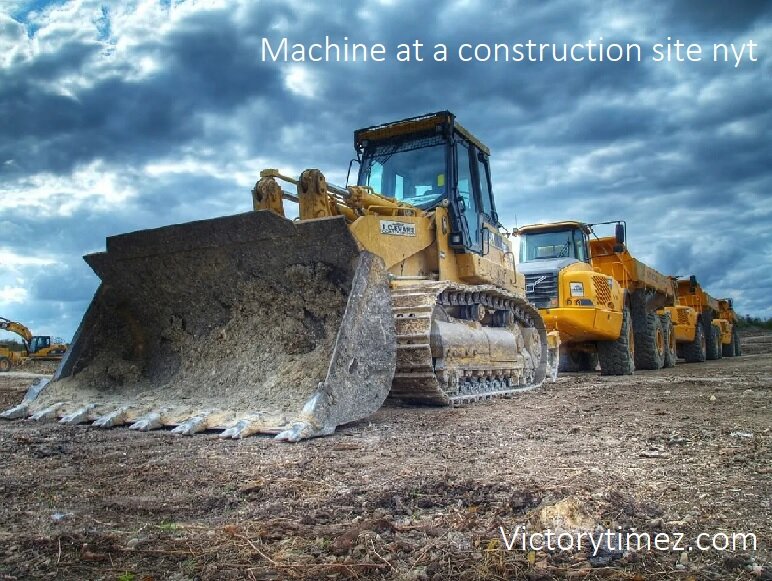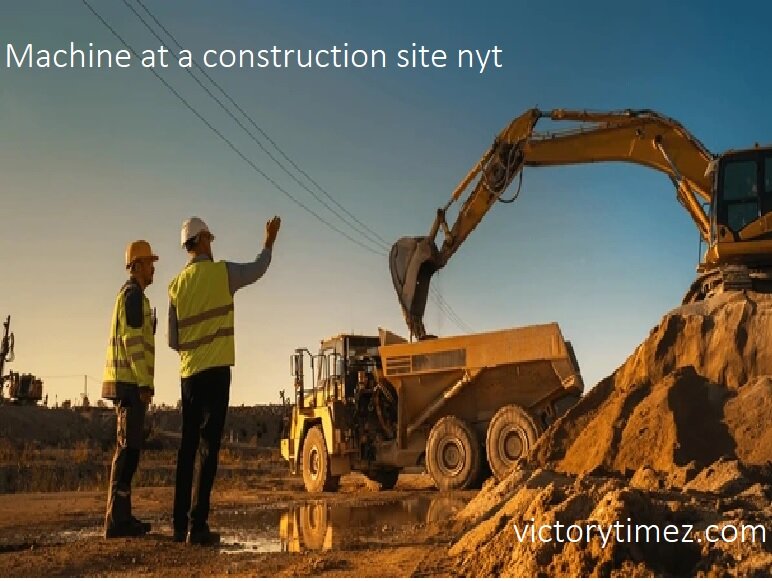
Introduction
Machine at a construction site nyt have transformed dramatically over the years, and much of this change can attributed to the machinery used. From the simplicity of early hand tools to the sophistication of today’s automated systems, Machine at a construction site nyt plays a pivotal role in shaping the landscape of the industry. This article delves into the evolution, types, benefits, challenges, and future trends of construction machinery, highlighting how these machines are revolutionizing construction.
Machine at a construction site nyt
Early Tools and Equipment
In the earliest days of construction, simple hand tools like hammers, chisels, and rudimentary cranes were the norm. These tools required significant manual labor and have limited in their efficiency and capability.
Introduction of Mechanized Equipment
The industrial revolution marked a significant shift with the introduction of steam-powered equipment. Machines like steam shovels and cranes began to reduce the labor intensity of construction tasks.
Modern Advancements in Construction Machinery
Today’s Machine at a construction site nyt is a testament to technological advancement. Hydraulic systems, advanced materials, and computer-aided design have resulted in powerful, efficient, and versatile machines that can perform complex tasks with precision.
- Types of Construction Machines
- Excavators
- Functions and Uses
Excavators have versatile machines used for digging, trenching, and material handling. Their hydraulic systems allow for precise control, making them indispensable on construction sites.
Key Features
Modern excavators come with features like GPS for precision digging, advanced hydraulic systems for smooth operation, and interchangeable attachments for various tasks.
- Bulldozers
- Primary Applications
Bulldozers have primarily used for earthmoving, grading, and demolition. Their robust design allows them to push large quantities of material, clear land, and level surfaces efficiently.
Innovations in Design
Recent innovations include GPS systems for accurate grading, improved blade designs for better material handling, and more efficient engines to reduce fuel consumption.
Cranes
Varieties and Their Specific Uses
Cranes come in various forms, including tower cranes, mobile cranes, and crawler cranes. Each type has designed for specific tasks, such as lifting heavy materials, assembling large structures, and reaching significant heights.
Loaders

Differences Between Types
Loaders, including skid-steer, front-end, and backhoe loaders, have used for moving materials, loading trucks, and excavation. Each type offers unique benefits based on the task at hand.
Common Uses
Loaders have commonly used for digging, lifting, and transporting materials on construction sites. Their versatility makes them a staple in the construction industry.
Concrete Mixers
Machine at a construction site nyt
Concrete mixers are essential for preparing concrete on-site, ensuring the right mix and consistency for construction projects. They range from small portable mixers to large truck-mounted units.
Technological Improvements
Machine at a construction site nyt mixers have equipped with automated systems for precise measurement and mixing, reducing waste and improving the quality of the final product.
Benefits of Using Machinery in Construction
Increased Efficiency and Productivity
Machinery significantly speeds up construction processes, allowing for faster project completion and higher productivity.
Enhanced Safety
Machines reduce the need for manual labor in dangerous tasks, thus enhancing worker safety and reducing the likelihood of accidents.
Cost-Effectiveness
While the initial investment in machinery can be high, the long-term savings in labor costs and increased efficiency often outweigh these costs.
Precision and Quality
Advanced machinery allows for high precision in construction tasks, leading to better quality work and fewer errors.
Challenges in Implementing Construction Machinery
High Initial Costs
The cost of purchasing and maintaining construction machinery can be prohibitive for smaller companies.
Maintenance and Repairs
Machinery requires regular maintenance and occasional repairs, which can be costly and time-consuming.
Skill Requirements for Operation
Operating modern construction machinery often requires specialized skills and training, which can be a barrier for some workers.
Integration with Existing Systems
Integrating new machinery with existing construction processes and systems can be challenging and may require significant adjustments.
The Role of Automation and AI in Construction Machinery
Introduction to Automation in Construction
Automation is transforming the construction industry by reducing the need for manual labor and increasing efficiency.
Examples of AI-Driven Machinery
AI-driven machines, such as autonomous bulldozers and robotic bricklayers, are becoming more common, performing tasks with high precision and speed.
Future Prospects
The future of AI in construction machinery looks promising, with potential developments including fully autonomous construction sites and advanced predictive maintenance systems.
Case Studies: Successful Implementation of Construction Machinery
Notable Projects and Their Outcomes
Projects like the construction of the Burj Khalifa and the Panama Canal showcase the successful implementation of advanced machinery, resulting in timely and efficient project completion.
Lessons Learned
These projects highlight the importance of careful planning, skilled operation, and regular maintenance in the successful use of construction machinery.
- Environmental Impact of Construction Machinery
- Emissions and Energy Consumption
Construction machinery contributes to emissions and energy consumption. However, efforts have made to develop more environmentally friendly options.
Innovations for Sustainability
Innovations such as electric and hybrid machines, as well as biofuel options, are helping to reduce the environmental impact of construction machinery.
Regulatory Standards and Compliance
Governments and organizations are implementing stricter regulations and standards to ensure the environmental sustainability of construction machinery.
Future Trends in Construction Machinery
Electric and Hybrid Machines
The development of electric and hybrid construction machinery has gaining momentum, promising reduced emissions and operational costs.
Autonomous Construction Vehicles
Autonomous vehicles have set to revolutionize the industry by performing tasks without human intervention, increasing efficiency, and safety.
Smart Construction Sites
Smart construction sites utilize IoT devices and AI to monitor and optimize construction processes, leading to more efficient and sustainable practices.
Conclusion
The evolution of Machine at a construction site nyt has transformed the industry, making it more efficient, safer, and sustainable. While challenges remain, ongoing innovations promise an exciting future for construction machinery. As technology continues to advance, the possibilities for further improvements in construction efficiency and quality are limitless.
FAQs about machine at a construction site nyt
What are the most common machines at a construction site?
The most common machines include excavators, bulldozers, cranes, loaders, and concrete mixers.
How has AI impacted construction machinery?
AI has introduced automation, increased precision, and improved safety, with machines like autonomous bulldozers and robotic bricklayers becoming more prevalent.
What are the environmental benefits of modern construction machinery?
Modern machinery includes electric and hybrid options that reduce emissions, and advancements in technology improve fuel efficiency and sustainability.
How can construction companies manage the high costs of machinery?
Companies can manage costs through leasing options, regular maintenance to extend machinery life, and investing in training for efficient operation.
What future technologies can we expect in construction machinery?
Future technologies include fully autonomous construction vehicles, smart construction sites utilizing IoT, and further developments in sustainable machinery.